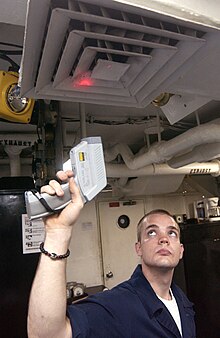Pyrometer


A pyrometer is a non-contacting device that intercepts and measures thermal radiation, a process known as pyrometry. This device can be used to determine the temperature of an object's surface.
The word pyrometer comes from the Greek word for fire, "πυρ" (pyro), and meter, meaning to measure. Pyrometer was originally coined to denote a device capable of measuring temperatures of objects above incandescence (i.e. objects bright to the human eye).
Principle of operation
A pyrometer has an optical system and detector. The optical system focuses the thermal radiation onto the detector. The output signal of the detector (Temperature T) is related to the thermal radiation or irradiance j* of the target object through the Stefan–Boltzmann law, the constant of proportionality σ, called the Stefan-Boltzmann constant and the emissivity ε of the object.
This output is used to infer the object's temperature. Thus, there is no need for direct contact between the pyrometer and the object, as there is with thermocouple and Resistance temperature detector (RTDs).
Applications
Pyrometer are suited especially to the measurement of moving objects or any surfaces that can not be reached or can not be touched.
Smelter Industry
Temperature is a fundamental parameter in metallurgical furnace operations. Reliable and continuous measurement of the melt temperature is essential for effective control of the operation. Smelting rates can be maximized, slag can be produced at the optimum temperature, fuel consumption is minimized and refractory life may also be lengthened. Thermocouples were the traditional devices used for this purpose, but they are unsuitable for continuous measurement because they rapidly dissolve.
Over-the-bath Pyrometer
Continuous pyrometric measurement from above the bath surface is still employed, but is known to give poor results because of emissivity variations, interference by gases and particulate matter in the intervening atmosphere, and dust accumulation on the optics.
Tuyère Pyrometer
The Tuyère Pyrometer is an optical instrument for temperature measurement through the tuyeres which are normally used for feeding air or reactants into the bath of the furnace.

Steam boilers
A steam boiler may be fitted with a pyrometer to measure the steam temperature in the superheater.
External links
- The tuyère pyrometer patent
- Infrared and radiation pyrometers
- Portable, online and special pyrometer

